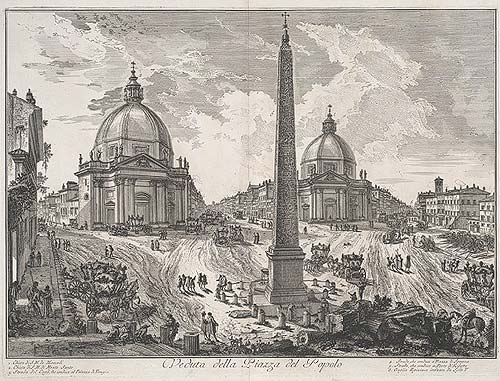【Paintings in Proust】 View of the Piazza del Popolo, from Views of Rome, Giovanni Battista Piranesi, 1750 (p.35)
「鐘樓」在小說中多次出現,普魯斯特甚至將鐘樓比喻為「上帝的手指」,這或許是一個最佳的註解:
「總之,無論你在哪裡,你的眼光都得落到鐘樓的身上,它總高踞於一切之上,在一個意想不到的高處把房舍召集到它的跟前。在我的心目中,它像上帝的手指;上帝本人可能隱跡於芸芸眾生之間,我並不會因此而混淆上帝與凡人的區別。」 (p.75 追憶似水年華 I 在斯萬家那邊 聯經版 1992)

【TEXT】
Even in Paris, in one of the ugliest parts of the town, I know a window from which one can see across a first, a second, and even a third layer of jumbled roofs, street beyond street, a violet bell, sometimes ruddy, sometimes too, in the finest ‘prints’ which the atmosphere makes of it, of an ashy solution of black; which is, in fact, nothing else than the dome of Saint-Augustin, and which imparts to this view of Paris the character of some of the Piranesi views of Rome. (Swann's Way)
甚至在巴黎,在最醜陋的地區,我記得有一個窗戶,從那裡望出去,是一幅由好幾條街道的凌亂的屋頂組成的畫面,你可以在前景、中景、甚至遠景的某個層次,看到一座紫色鐘樓的圓頂,有時它發紅,也有時,茫茫霧靄從灰濛濛中離析出黑影,洗印出最精美的“照片”,使它呈現為高雅的黑色,這就是聖奧古斯丁教堂的鐘樓,它使巴黎的這一景象,具有皮蘭內西筆下的某些羅馬風光的特徵。
(p.74 追憶似水年華 I 在斯萬家那邊 聯經版 1992)


 字體:小 中 大
字體:小 中 大

 字體:小 中 大
字體:小 中 大